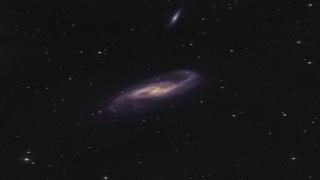Bibcode
Seibert, Mark; Gil de Paz, Armando; de Swardt, Bonita; Athanassoula, E.; Bosma, Albert; Lee, Myung Gyoon; Madore, Barry F.; Elmegreen, Bruce; Knapen, J. H.; Zaritsky, Dennis; Ho, Luis C.; Mizusawa, Trisha; Comerón, Sébastien; Kim, T.; Sheth, Kartik; Gadotti, Dimitri A.; Regan, Michael W.; Menéndez-Delmestre, Karín; Laine, Jarkko; Salo, Heikki; Laurikainen, Eija; Buta, Ron; Erroz-Ferrer, S.; Cisternas, M.; Muñoz-Mateos, Juan-Carlos; Hinz, Joannah L.; Holwerda, Benne
Referencia bibliográfica
The Astrophysical Journal, Volume 782, Issue 2, article id. 64, 19 pp. (2014).
Fecha de publicación:
2
2014
Revista
Número de citas
50
Número de citas referidas
47
Descripción
We have performed two-dimensional multicomponent decomposition of 144
local barred spiral galaxies using 3.6 μm images from the Spitzer
Survey of Stellar Structure in Galaxies. Our model fit includes up to
four components (bulge, disk, bar, and a point source) and, most
importantly, takes into account disk breaks. We find that ignoring the
disk break and using a single disk scale length in the model fit for
Type II (down-bending) disk galaxies can lead to differences of 40% in
the disk scale length, 10% in bulge-to-total luminosity ratio (B/T), and
25% in bar-to-total luminosity ratios. We find that for galaxies with
B/T >= 0.1, the break radius to bar radius, r br/R
bar, varies between 1 and 3, but as a function of B/T the
ratio remains roughly constant. This suggests that in bulge-dominated
galaxies the disk break is likely related to the outer Lindblad
resonance of the bar and thus moves outward as the bar grows. For
galaxies with small bulges, B/T < 0.1, r br/R
bar spans a wide range from 1 to 6. This suggests that the
mechanism that produces the break in these galaxies may be different
from that in galaxies with more massive bulges. Consistent with previous
studies, we conclude that disk breaks in galaxies with small bulges may
originate from bar resonances that may be also coupled with the spiral
arms, or be related to star formation thresholds.
Proyectos relacionados

Las Galaxias Espirales: Evolución y Consecuencias
Nuestro grupo pequeño esta bien conocido y respetado internacionalmente por nuestro trabajo inovativo e importante en varios aspectos de la estructura y la evolución de las galaxias espirales cercanas. Usamos principalmente observaciones en varias longitudes de onda, explotando las sinergías que nos permiten responder a las cuestiones más
Johan Hendrik
Knapen Koelstra